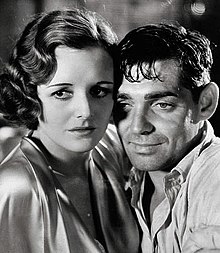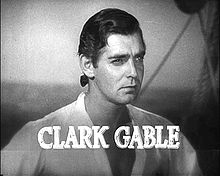Birthday:
1 February 1901, Cadiz, Ohio, USA
Height:
6' 1" (1.85 m)
Biography
Clark Gable's mother died when he was seven months
old. At 16 he quit high school, went to work in an Akron (Ohio) tire
factory and decided to become an actor after seeing the play "The Bird
of Paradise". He toured in stock companies, worked oil fields and sold
ties. In 1924 he reached Hollywood with the help of Portland, Oregon,
theatre manager Josephine Dillon, who coached and later married him (she
was 17 years his senior). After playing a few bit parts he returned to
the stage, becoming lifelong friends with Lionel Barrymore. After
several failed screen tests (for Barrymore and Darryl F. Zanuck), Gable
was signed in 1930 by MGM's Irving Thalberg. Joan Crawford asked for him
as co-star in Dance, Fools, Dance (1931) and the public loved him
manhandling Norma Shearer in A Free Soul (1931) the same year. His
unshaven lovemaking with bra-less Jean Harlow in Red Dust (1932) made
him MGM's most important star. At one point he refused an assignment and
the studio punished him by loaning him out to (at the time) low-rent
Columbia Pictures, which put him in Frank Capra's It Happened One Night
(1934), which won him an Oscar. He returned to far more substantial
roles at MGM, such as Fletcher Christian in Mutiny on the Bounty (1935)
and Rhett Butler in Gone with the Wind (1939). When his third wife
Carole Lombard died in a plane crash returning from a War Bond drive, a
grief-stricken Gable joined the US Army Air Force and was off the screen
for three years, flying combat missions in Europe. When he returned the
studio regarded his salary as excessive and did not renew his contract.
He freelanced, but his films didn't do well at the box office. He
announced during filming of The Misfits (1961) that, for the first time,
he was to become a father. Two months later he died of a heart attack.
He was laid to rest beside Carole Lombard at Forest Lawn Cemetery
In 1930, after his impressive appearance as the seething and
desperate character Killer Mears in the Los Angeles stage production of The Last Mile, Gable was offered a contract with MGM. His first role in a sound picture was as the unshaven villain in a low-budget William Boyd western called The Painted Desert (1931). He received a lot of fan mail as a result of his powerful voice and appearance; the studio took notice.
In 1930, Gable and Josephine Dillon were divorced. A few days later, he married Texas socialite Maria Franklin Prentiss Lucas Langham, nicknamed "Ria". After moving to California, they were married again in 1931, possibly due to differences in state legal requirements.

"His ears are too big and he looks like an ape", said Warner Bros. executive Darryl F. Zanuck about Clark Gable after testing him for the lead in Warner's gangster drama Little Caesar (1931).[14] The same year, in Night Nurse, Gable played a villainous chauffeur who was gradually starving two adorable little girls to death, then knocked Barbara Stanwyck's character unconscious with his fist, a supporting role originally slated for James Cagney until the release of The Public Enemy abruptly made Cagney a leading man. After several failed screen tests for Barrymore and Zanuck, Gable was signed in 1930 by MGM's Irving Thalberg. He became a client of well-connected agent Minna Wallis, sister of producer Hal Wallis and very close friend of Norma Shearer.
Gable's timing in arriving in Hollywood was excellent, as MGM was
looking to expand its stable of male stars and he fit the bill. Gable
first worked mainly in supporting roles, often as the villain. He made
two pictures in 1931 with Wallace Beery, a minor role in The Secret Six, then with his part increasing in size to almost match Beery's in the naval aviation film Hell Divers.
MGM's publicity manager Howard Strickland developed Gable's studio
image, playing up his he-man experiences and his 'lumberjack in evening
clothes' persona.[citation needed]
To bolster his rocketing popularity, MGM frequently paired him with well-established female stars. Joan Crawford asked for him as her co-star in Dance, Fools, Dance (1931). He built his fame and public visibility in such movies as A Free Soul
(1931), in which he played a gangster who shoved the character played
by Norma Shearer (Gable never played a supporting role again). The Hollywood Reporter
wrote "A star in the making has been made, one that, to our reckoning,
will outdraw every other star... Never have we seen audiences work
themselves into such enthusiasm as when Clark Gable walks on the
screen".[15] He followed that with Susan Lenox (Her Fall and Rise) (1931) with Greta Garbo, and Possessed (1931), in which he and Crawford (then married to Douglas Fairbanks, Jr.) steamed up the screen. Adela Rogers St. Johns later dubbed Gable and Crawford's real-life relationship as "the affair that nearly burned Hollywood down".[16] Louis B. Mayer threatened to terminate both their contracts, and for a while they kept apart. Gable shifted his attentions to Marion Davies. On the other hand, Gable and Garbo disliked each other. She thought he was a wooden actor while he considered her a snob.[citation needed]
Rising star

Gable was considered for the role of Tarzan the Ape Man but lost out to Johnny Weissmuller's more imposing physique and superior swimming prowess. However Gable's unshaven lovemaking with braless Jean Harlow in Red Dust (1932) soon made him MGM's most important male star. After the hit Hold Your Man (1933), MGM recognized the goldmine of the Gable-Harlow pairing, putting them in two more films, China Seas (1935; with Gable and Harlow billed above Wallace Beery) and Wife vs. Secretary (1936). An enormously popular combination, on-screen and off-screen, Gable and Jean Harlow made six films together, the most notable being Red Dust (1932) and Saratoga (1937). Harlow died during production of Saratoga. Ninety percent completed, the remaining scenes were filmed with long shots or the use of doubles like Mary Dees; Gable would say that he felt as if he was "in the arms of a ghost".[17]
According to legend, Gable was lent to Columbia Pictures,
then considered a second-rate operation, as punishment for refusing
roles; however, this has been refuted by more recent biographies. MGM did not have a project ready for Gable and was paying him $2000 per week, under his contract, to do nothing. Studio head Louis B. Mayer lent him to Columbia for $2500 per week, making a $500 per week profit.[4]
Gable was not the first choice to play the lead role of Peter Warne in It Happened One Night (1934). Robert Montgomery was originally offered the role, but he felt that the script was poor.[18] Filming began in a tense atmosphere,[4] but both Gable and Frank Capra enjoyed making the movie, although Colbert reportedly did not. Gable and Colbert won the Academy Award for Best Actor and Best Actress for their performances in the film, and the movie itself won the Academy Award for Best Picture. He returned to MGM a bigger star than ever.[19]

The unpublished memoirs of animator Friz Freleng mention that this was one of his favorite films. It has been claimed that it helped inspire the cartoon character Bugs Bunny.
Four things in the film may have coalesced to create Bugs: the
personality of a minor character, Oscar Shapely, and his penchant for
referring to Gable's character as "Doc;" an imaginary character named
"Bugs Dooley" that Gable's character uses to frighten Shapely; and most
of all, a scene in which Clark Gable eats carrots while talking quickly
with his mouth full, as Bugs does.[20]
Gable also earned an Academy Award nomination for his portrayal of Fletcher Christian in 1935's Mutiny on the Bounty.


0 comments:
Post a Comment